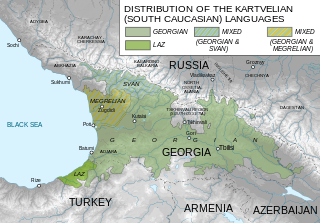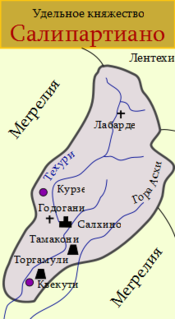Giorgi III Gurieli, of the Georgian House of Gurieli, was Prince of Guria from 1669 to 1684 and King of Imereti from 1681 to 1683. He was energetically involved in civil wars in western Georgian polities, which he sought to bring under his sway. He was killed in battle while trying to recover the lost throne of Imereti.
Giorgi IV Gurieli, of the House of Gurieli, was Prince of Guria from 1711 to 1726, and a king of Imereti in western Georgia in 1716. He was installed as regent of Guria by his father, Mamia III Gurieli, then the king of Imereti, in 1712. In 1716, he seized the crown of Imereti, but was forced to abandon the enterprise later that year. Returning to Guria, his rule was challenged by a faction of local nobility, which included his mother Elene and brother Kaikhosro III Gurieli. He was finally able to crush the opposition after making peace with Bezhan Dadiani, Prince of Mingrelia.

Levan I Dadiani was a member of the House of Dadiani and ruler of Odishi, that is, Mingrelia, in western Georgia. He succeeded on the death of his father, Mamia III Dadiani, as eristavi ("duke") of Odishi and ex officio mandaturt-ukhutsesi of Imereti in 1533. Dadiani's break with the king of Imereti brought about his downfall and imprisonment in 1546. He was able to escape and regain his possessions, securing Ottoman support for his independence from Imereti.
Giorgi III Dadiani was Prince of Mingrelia, of the House of Dadiani, from 1572 to 1573 and again from 1578 until his death. He was a son and successor of Levan I Dadiani.
Mamia IV Dadiani was Prince of Mingrelia, of the House of Dadiani, from 1573 to 1578 and again from 1582 until his death. He was a younger son of Levan I Dadiani.
Levan III Dadiani, born Shamadavle (შამადავლე) was Prince of Mingrelia, of the House of Dadiani, from 1661 to 1680. His reign unfolded against the background of a series of civil wars in western Georgian polities, in which Levan III was an opponent of King Bagrat V of Imereti to whom he lost a battle and his own wife.
Levan IV Dadiani was Prince of Mingrelia from 1681 until 1691, when he was forced to abdicate and retire to Constantinople, where he died. A natural son of the preceding Levan III Dadiani, he was the last of the First House of Dadiani to rule Mingrelia, a principality in western Georgia. The succeeding dynasty were the Chikovani, who assumed the surname of Dadiani and continued to rule Mingrelia until 1867.
Bezhan Dadiani, of the House of Dadiani, was Prince of Mingrelia from 1715 to 1728. He acceded to power in a coup against his own father, Giorgi IV Dadiani, and came to dominate western Georgian politics by asserting tutelage over King Alexander V of Imereti until being murdered by Ottoman agents.
Otia Dadiani, of the House of Dadiani, was Prince of Mingrelia from 1728 until his death. Like his predecessors, Otia Dadiani was embroiled in a series of civil wars that plagued western Georgia. He spent years fighting King Alexander V of Imereti with varying fortune. In the last years of his rule, Otia reconciled and corroborated with the Imeretian monarchy.
Katsia II Dadiani, of the House of Dadiani, was Prince of Mingrelia from 1758 to 1788. His rule was dominated by complicated relations with the Kingdom of Imereti, which claimed suzerainty over all of western Georgia. In efforts to further his precarious sovereignty, Dadiani easily switched sides, allying himself, alternatively, with the Imeretians, Russians, and Ottomans, as exemplified by his vacillating position during the Russo-Turkish War (1768–1774).
Grigol Dadiani, of the House of Dadiani, was Prince of Mingrelia from 1788 to 1804, with intermissions from 1791 to 1794 and in 1802 when his position was filled by his rivaling brothers. His rule was marred by the long-standing struggle between the Imeretian crown seeking to subdue Mingrelia and Mingrelian efforts to win full independence, a continuation of the conflict which had plagued western Georgia for centuries. Grigol's rapprochement with the expanding Russian Empire resulted in Mingrelia becoming, in 1804, a Russian subject with a degree of internal autonomy under the Dadiani dynasty, an arrangement which remained in place until 1856.
Nikoloz "Didi-Niko" Dadiani was a Georgian nobleman of the House of Dadiani and a historian. He played a prominent role in the government of the Principality of Mingrelia, which became an autonomous subject of the Russian Empire in 1804. Dadiani's principal historical work is The History of the Georgians, whose final chapters are an indispensable source for the early modern history of western Georgia. Nikoloz Dadiani, his name hypocorized to Niko, was named didi, Georgian for "big", to distinguish him from his younger namesakes in the Dadiani family.
Rostom Gurieli, of the House of Gurieli, was Prince of Guria from 1534 until his death in 1564. Alongside his royal suzerain, Bagrat III of Imereti, Rostom fought against the expanding Ottoman Empire to which he lost parts of his principality. Rostom's relations with Bagrat III subsequently deteriorated over his support to the king's defiant vassal, Levan I Dadiani.
Giorgi II Gurieli, of the House of Gurieli, was Prince of Guria from 1564 to 1583 and again from 1587 to 1600. Succeeding on the death of his father Rostom Gurieli, Giorgi's rule over his small principality, located in southwest Georgia, was a period of conflict with the neighboring Dadiani of Mingrelia and increasing assertiveness of the Ottomans whom Gurieli submitted in 1581. His reign was interrupted, from 1583 to 1587, by a Mingrelian invasion, but Giorgi was able to resume the throne with Ottoman support.
Vakhtang I Gurieli, of the House of Gurieli, was Prince of Guria from 1583 to 1587. He ruled Guria, a small state in southwestern Georgia, as a client of Mamia IV Dadiani, Prince of Mingrelia, who had deposed Giorgi II Gurieli. Vakhtang was one of the sponsors of the Shemokmedi Monastery, Guria's principal cathedral.
Kaikhosro I Gurieli, of the House of Gurieli, was Prince of Guria from 1626 to 1658. He was installed by Levan II Dadiani, Prince of Mingrelia, in place of his deposed predecessor Simon I Gurieli. In his turn, Kaikhosro was overthrown and expelled by King Alexander III of Imereti. His comeback to Guria, in an Ottoman-supported endeavor, concluded with his assassination by a Gurian nobleman.
Mamia IV Gurieli, of the western Georgian House of Gurieli, was Prince of Guria from 1726 to 1756 and again from 1758 to 1765 and from 1771 to 1776. Intermissions of his rule was the result of Mamia's rivalry with his younger brother, Giorgi V Gurieli, and complex political situation in the region, including the Ottoman encroachments and efforts by the kings of Imereti to bring western Georgian polities under their supreme authority.






